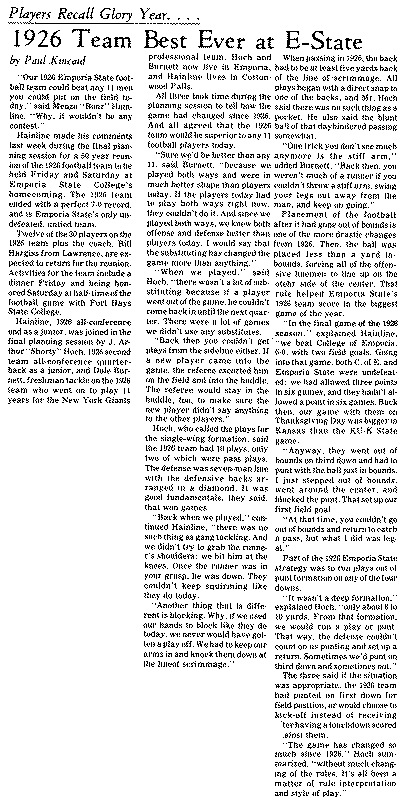|
|
Players Recall Glory Year....
1926 Team Best Ever at E-State
by Paul Kincaid
"Our 1926 Emporia State football team could beat any 11
men you could put on the field today," said Menzo "Bonz" Hainline. "Why, it wouldn't
be any contest.
Hainline made his comments last week during the final planning
session for a 50 year reunion of the 1926 football team to be held Friday and Saturday
at Emporia State College's homecoming. The 1926 team ended with a perfect 7-0 record,
and is Emporia State's only undefeated, untied team.
Twelve of the 30 players on the 1926 team plus the coach,
Bill Hargiss from Lawrence, are expected to return for the reunion. Activities for
the team include a dinner Friday and being honored Saturday at half-time of the
football game with Fort Hays State College.
Hainline, 1926 all-conference end as a junior, was joined
in the final planning session by J. Arthur "Shorty" Hoch, 1926 second team all-conference
quarterback as a junior, and Dale Burnett, freshman tackle on the 1926 team who
went on to play 11 years for the New York Giants professional team. Hoch and Burnett
now live in Emporia, and Hainline lives in Cottonwood Falls.
All three took time during the planning session to tell
how the game had changed since 1926. And all agreed that the 1926 team would be
superior to any 11 football players today.
"Sure we'd be better than any 11", said Burnett, "because we
played both ways and were in much better shape than players today. If the players
today had to play both ways right now, they couldn't do it. And since we played
both ways, we knew both offense and defense better than players today. I would say
that the substituting has changed the game more than anything."
"When we played," said Hoch, "there wasn't a lot of substituting
because if a player went out of the game, he couldn't come back in until the next
quarter. There were a lot of games we didn't use any substitutes."
"Back then you couldn't get plays from the sideline either.
If a new player came into the game, the referee escorted him on the field and into
the huddle. The referee would stay in the huddle too, to make sure the new player
didn't say anything to the other players."
Hoch, who called the plays for the single-wing formation,
said the 1926 team had 10 plays, only two of which were pass plays. The defense
was seven-man line with the defensive backs arranged in a diamond. It was good fundamentals,
they said, that won games.
"Back when we played," continued Hainline, "there was no
such thing as gang tackling. And we didn't try to grab the runner's shoulders; we
hit him at the knees. Once the runner was in your grasp, he was down. They couldn't
keep squirming like they do today."
"Another thing that is different is blocking. Why, if we
used our hands to block like they do today, we never would have gotten a play off.
We had to keep our arms in and knock them down at the line of scrimmage."
When passing in 1926, the back had to be at least five
yards back of the line of scrimmage. All plays began with a direct snap to one of
the backs, and Mr. Hoch said there was no such thing as a pocket. He also said the
blunt ball of that day hindered passing somewhat.
"One trick you don't see much anymore is the stiff arm,"
added Burnett. "Back then, you weren't much of a runner if you couldn't throw a
stiff arm, swing your legs out away from the man, and keep on going."
Placement of the football after it had gone out of bounds
is one of the more drastic changes from 1926. Then, the ball was placed less than
a yard in-bounds, forcing all of the offensive linemen to line up on the other side
of the center. That rule helped Emporia State's 1926 team score in the biggest game
of the year.
"In the final game of the 1926 season," explained Hainline,
"we beat College of Emporia, 6-0, with two field goals. Going into that game, both
C. of E. and Emporia State were undefeated; we had allowed three points in six games,
and they hadn't allowed a point in six game's. Back then, our game with them on
Thanksgiving Day was bigger in Kansas than the KU-K State game."
"Anyway, they went out of bounds on third down and had
to punt with the ball just in bounds. I just stepped out of bounds, went around
the center, and blocked the punt. That set up our first field goal."
"At that time, you couldn't go out of bounds and return
to catch a pass, but what I did was legal."
Part of the 1926 Emporia State strategy was to run plays
out of punt formation on any of the four downs.
"It wasn't a deep formation," explained Hoch, "only about
8 to 10 yards. From that formation, we would run a play or punt. That way the defense
couldn't count on us punting and set up a return. Sometimes we'd punt on third down
and sometimes not."
The three said if the situation was appropriate, the 1926
team had punted on first down for field position, or would choose to kick-off instead
of receiving after having a touchdown scored against them.
"The game has changed so much since 1926," Hoch summarized,
"without much changing of the rules. It's all been a matter of rule interpretation
and style of play."